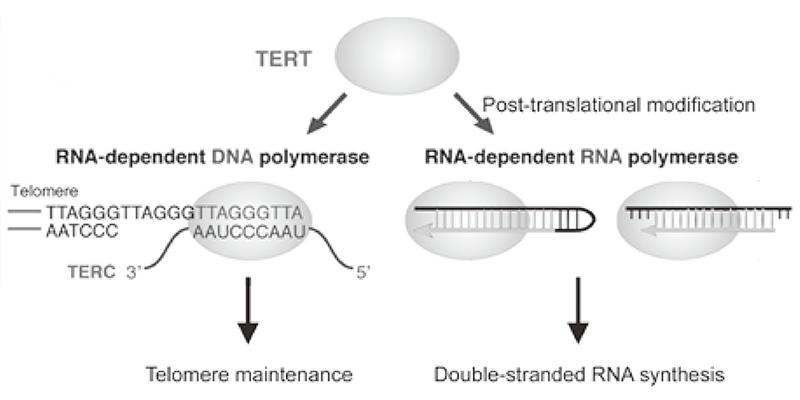Annual Report 2018
Division of Cancer Stem Cell
Kenkichi Masutomi, Yoshinari Ando, Mami Yasukawa, Marco Ghilotti, Saori Ueki, Michie Yoshikawa
Introduction
Research in the Division of Cancer Stem Cell is focused on deciphering the mechanisms that establish and maintain cancer stem cells and developing novel therapeutic approaches to treat cancer stem cells. In particular, our division studies the molecular links between a) telomerase and RNA-dependent RNA polymerase (RdRP); b) TERT and cancer stem cells; and c) RdRP and anticancer drugs.
Research activities
1. Telomerase and RNA-dependent RNA polymerase
Telomerase is a ribonucleoprotein complex that elongates telomeres. Human telomerase reverse transcriptase (TERT) is known as the catalytic subunit of telomerase and acts as an RNA-dependent DNA polymerase (RdDP), which synthesizes telomere DNA repeats from an RNA template TERC. Although the major function of TERT is believed to be telomere elongation, emerging evidence indicates that TERT exhibits various functions beyond telomere maintenance. We reported that TERT has an RNA-dependent RNA polymerase (RdRP) activity and synthesizes double-stranded RNA (dsRNA) in either a primer-dependent or a primer-independent manner1, 2. Moreover, our recent studies identified that TERT-RdRP activity is regulated by posttranslational modifications (Figure 1).
Figure 1. TERT exerts RdRP activity


2. TERT and cancer stem cells
Previous studies indicated that TERT has activities beyond telomere maintenance, and it is speculated that the constitutive expression of TERT not only stabilizes telomere length and facilitates cell immortalization, but also contributes to tumor susceptibility and alters stem cell cycling in vivo even when telomere lengths are not limited. We found that the RdRP activity directly contributes to cancer progression
3. RdRP and anticancer drugs
We further confirmed that the expression levels of TERT protein and the RdRP activities are positively correlated in various human cancer cell lines2 , indicating that RdRP inhibitors may work effectively for many types of tumors with high levels of TERT expression. We are continuing to discover and characterize novel inhibitors of TERT-RdRP activity as anticancer drugs.
References
1. Maida Y, et al. An RNA-dependent RNA polymerase formed by TERT and the RMRP RNA. Nature, 461:230-235, 2009.
2. Maida Y, et al. De novo RNA synthesis by RNA-dependent RNA polymerase activity of TERT. Mol Cell Biol, 36:1248-1259, 2016
List of papers published in 2018
Journal
1. Miki S, Imamichi S, Fujimori H, Tomiyama A, Fujimoto K, Satomi K, Matsushita Y, Matsuzaki S, Takahashi M, Ishikawa E, Yamamoto T, Matsumura A, Mukasa A, Nishikawa R, Masutomi K, Narita Y, Masutani M, Ichimura K. Concomitant administration of radiation with eribulin improves the survival of mice harboring intracerebral glioblastoma. Cancer Sci, 109:2275-2285, 2018
2. Masui K, Komori T, Kato Y, Masutomi K, Ichimura K, Ogasawara S, Kaneko MK, Oki H, Suzuki H, Nitta M, Maruyama T, Muragaki Y, Kawamata T, Sawada T, Shibata N. Elevated TERT Expression in TERT-Wildtype Adult Diffuse Gliomas: Histological Evaluation with a Novel TERT-Specific Antibody. Biomed Res Int, 2018:7945845, 2018
3. Maekawa T, Liu B, Nakai D, Yoshida K, Nakamura KI, Yasukawa M, Koike M, Takubo K, Chatton B, Ishikawa F, Masutomi K, Ishii S. ATF7 mediates TNF-alpha-induced telomere shortening. Nucleic Acids Res, 46:4487-4504, 2018
4. Maida Y, Yasukawa M, Ghilotti M, Ando Y, Masutomi K. Semi-quantitative Detection of RNA-dependent RNA Polymerase Activity of Human Telomerase Reverse Transcriptase Protein. J Vis Exp, 2018
